We are still about a month away from the Ivy Bridge-EP “officially” being launched. It, of course, has been at large Intel customers for quite some time now. Those are the same customers that are already running Haswell-E silicon. For the rest of us, we are still running Sandy Bridge-EP. We already looked at the Sandy Bridge generation’s top dogs including the Hyper-Speed dual Intel Xeon E5-2687W configuration. Now it is time to look at the next-generation LGA2011 Xeon: the Intel Xeon E5-2697 V2. The Intel Xeon E5-2697 V2 is a monster of a chip. 12 cores running at 2.7GHz base clocks and 30MB of L3 cache all running within a 130w TDP. The shrink to a 22nm process yields significant results. In many ways this chip is similar to the Sandy Bridge generation Intel Xeon E5-2680, except the die shrink allows for 50% more cores and cache. Intel also increases the price significantly and rumor has it that these chips will sell for just shy of $3,000 each. Let’s see how the processors compares in our linux benchmarking suite.
Test Configuration
For this test we did not receive any vendor support. Also since these chips have still yet to be released we are using a motherboard which with the latest BIOS update is ready to take the Ivy Bridge Xeon E5 V2 chips. It is good to see that socket compatibility is extending easily to a new generation of processors. It is unlikely we will see any major new motherboard redesigns for Intel Xeon E5 processors this year, but we may see some incremental updates.
- Processor: 1x Intel Xeon E5-2697
- Motherboard: Dual LGA2011 (C602 based) with BIOS update
- Memory: 4x 8GB Registered ECC DDR3 1600MHz DIMMs
Since we are not running disk tests and we want to keep sources confidential, we are only publishing this abbreviated list. We also did not get to utilize newer 1866MHz DDR3 RDIMMs for this benchmarking session. The silicon is a later revision chip showing a full 2.7GHz clock speed and Hyper-Threading and Turbo Boost available.
Intel Xeon E5-2697 V2 Benchmarks
Our Linux CPU test suite combines both single threaded and multi-threaded benchmarks. As we expect, in some of the tests the 12-core Intel Xeon E5-2697 V2 performs worse than inexpensive single socket, higher frequency processors that cost less than 1/10th the price. These chips are meant for high-end servers where many threads will be running simultaneously. Still, it is important to see performance from both angles. As a note, the crafty chess results were not received properly so we are
Hardinfo Performance
hardinfo is a well known Linux benchmark that has been around for years. It tests a number of CPU performance aspects.
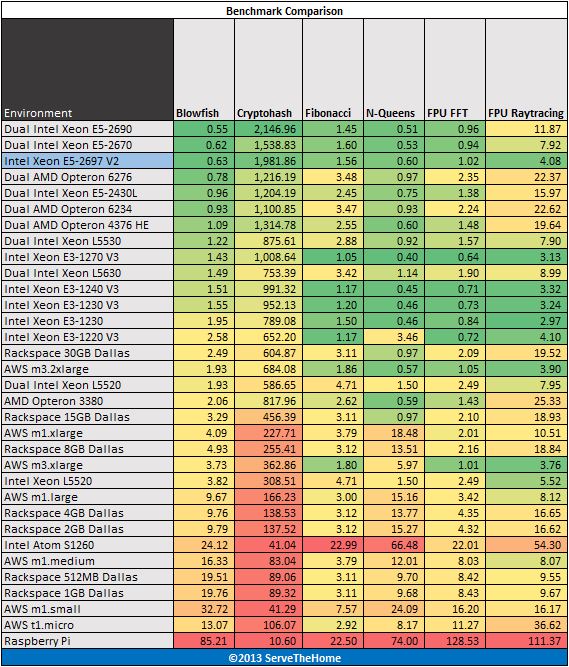
Here we are seeing two things play out. First, we see the slightly higher IPC figure assisting the single-threaded results while some of the multi-threaded results are clearly assisted by the bump to 12 cores on a single die. What we will see today is that the architecture almost looks like more of a previous-generation dual processor system on a single chip.
UnixBench 5.1.3 Performance
UnixBench may be a defacto standard for Linux benchmarking these days. There are two main versions, one that tests single CPU performance on that tests multiple CPU performance. UnixBench segments these results. We run both sets of CPU tests. Here are the single threaded results:

In terms of single threaded performance, cache helps, but clockspeed keeps the Intel Xeon E3 line generally ahead. Also as we may expect, the CPU performs very much in-line with other Xeon E5 processors we have seen. At the end of the day though, these chips are built for multi-threaded applications. Here is the more applicable set of results:
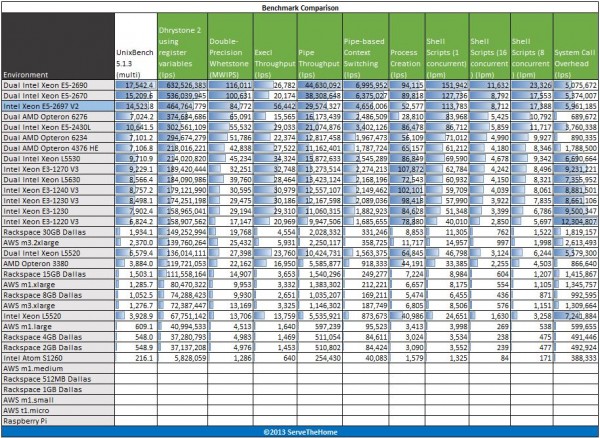
For these charts, we did sort by Dhrystone 2 results in this test. The key takeaway here is that there is an entire generation of systems that can move from a full 2U box to a single chip.
c-ray 1.1 Performance
c-ray is a very interesting ray tracing benchmark. It provides both consistent results and some clear separation. Ray tracing is generally a great multi-threaded CPU benchmark. For this test we use both a simple 7500×3500 render and a more complex 1920×1200 render. Here are the results:
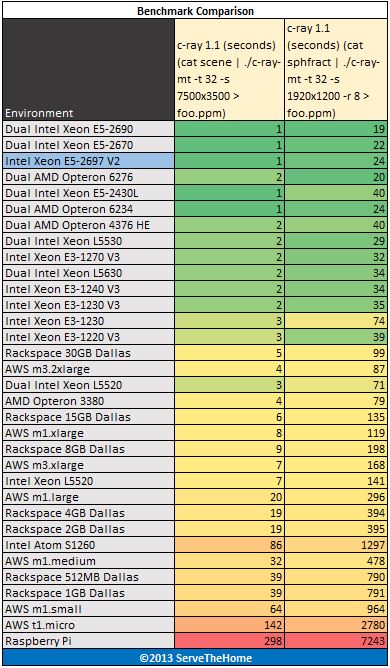
As we may expect, the massive single-die architecture performs very well in these tests, performing similar to a previous-generation dual-CPU system. The chip was able to complete our less complex render in about a second and our more complex render in approximately 24. These were the same results we saw with our dual AMD Opteron 6234 system.
Phoronix Test Suite Performance
We are using four tests from the Phoronix Test Suite: pts/stream, pts/compress-7zip, pts/openssl and pts/pybench.
- STREAM by John D. McCalpin, Ph.D. is a very well known memory benchmark benchmark.
- 7-zip compression benchmarks were a mainstay in our Windows suite so we are including it again on the Linux side as a compression benchmark.
- The pts/openssl benchmark is very dependent on the CPU architecture being used
- Python is a widely used scripting language and pyBench is a nice single-threaded Python benchmark.
Here are the results of the Phoronix Test Suite benchmarks:
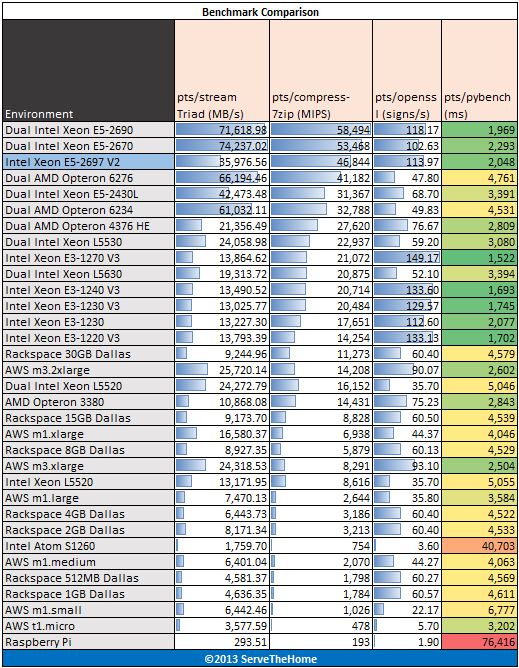
A few things are key here. First we see memory bandwidth is about half of our 2P Sandy Bridge-EP systems. We are using available 1600MHz DDR3 RDIMMs instead of the 1866MHz DDR3 that Ivy Bridge-EP can use. Of course, we are also only utilizing one processor so we would expect half of the memory bandwidth. Single threaded, again we see fairly standard figures. Multi-threaded and the picture again shows the Intel Xeon E5-2697 V2 is a very fast chip.
Conclusion
Unlike what we have seen from the Intel Xeon E3 series and the evolution, Intel is taking major strides in the server arena. For example, Sandy Bridge to Ivy Bridge typically brought the E3 series slightly lower TDP (~14% or so.) The die shrink on the Intel Xeon E3 side still was inhibited by a larger onboard GPU and as a result even in the Haswell generations E3 parts are still happy to see 7% IPC gains on a refresh. Without the GPU, the Intel Xeon E5 series is pushing the envelope and seeing more cores. Results for single-threaded benchmarks are exactly what we would expect. On the other hand, multi-threaded performance is pushing into new territory. Dual Intel Xeon E5-2697 V2 processors will cost a huge amount. In a datacenter replacing three last generation servers with two thanks to a 50% performance increase may be a significant cost savings. Any time the workhorse x86 server processors get updated it is certainly an interesting time. We will certainly have more to come on this soon!

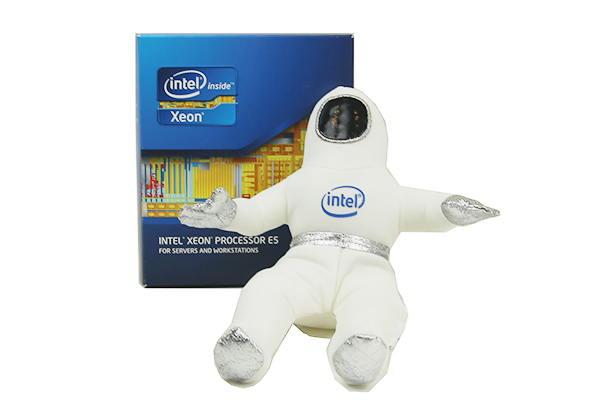



Thanks for the article,
Hopefully that means we’re going to see Gen 1 Xeon E5 going cheaper on eBay (not talking about Engineering Samples).
You guys are catching up with the other tech sites. I saw Tom’s had one on this too. Any connection? Either way, great you are able to have access to these scoops.
So can we setup a list of price/performance new/used? Like passmark but frugal!
IE $70 for L5639 or $20 for L5520 -> performance (single/threaded) -> wattage
$500 dual L5639 server performance per watt/per dollar compared to the new hotness plus feedback might lead more people to realize all that is new and shiny – maybe is not that much better? Or maybe it is!
Just received a nice new E5-2697v2 and it really does seem to fly.
http://browser.primatelabs.com/geekbench3/49155
That’s a boxed retail CPU. Not an eng sample.